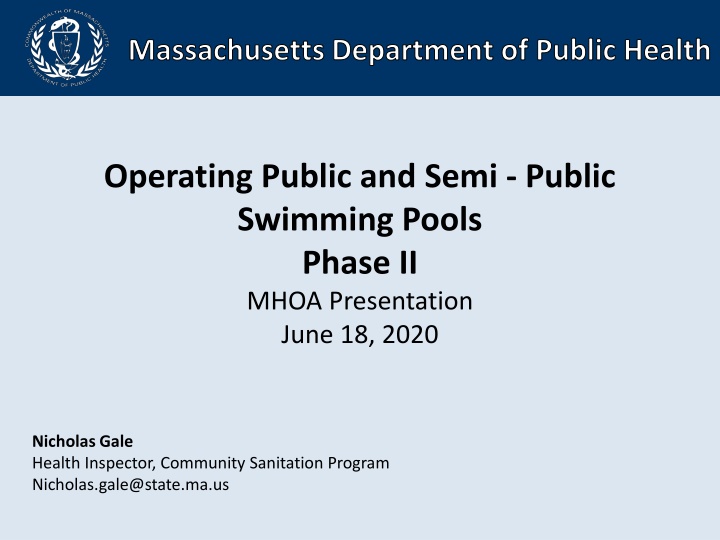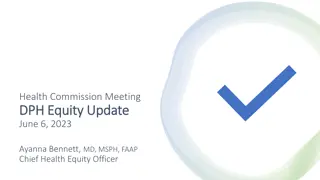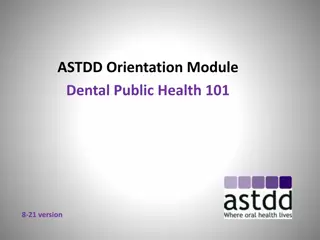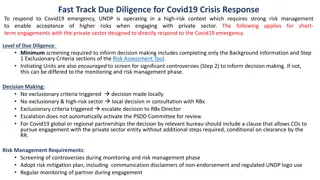
Public Swimming Pool Guidelines in Massachusetts During Phase II
Learn about the guidelines for operating public swimming pools in Massachusetts during Phase II, including restrictions on special purpose pools, social distancing requirements, face covering protocols, and necessary staff training. Follow CDC recommendations to ensure safety and prevent the spread of COVID-19.
Uploaded on | 21 Views
Download Presentation

Please find below an Image/Link to download the presentation.
The content on the website is provided AS IS for your information and personal use only. It may not be sold, licensed, or shared on other websites without obtaining consent from the author. If you encounter any issues during the download, it is possible that the publisher has removed the file from their server.
You are allowed to download the files provided on this website for personal or commercial use, subject to the condition that they are used lawfully. All files are the property of their respective owners.
The content on the website is provided AS IS for your information and personal use only. It may not be sold, licensed, or shared on other websites without obtaining consent from the author.
E N D
Presentation Transcript
Massachusetts Department of Public Health Operating Public and Semi - Public Swimming Pools Phase II MHOA Presentation June 18, 2020 Nicholas Gale Health Inspector, Community Sanitation Program Nicholas.gale@state.ma.us
What is allowed in Phase II? Indoor Public and Semi-Public Pools Indoor/Outdoor Special Purpose Pools Outdoor Public and Semi-Public Pools May open in Phase II in accordance with reopening guidance Special purpose pools (hot tubs, whirlpools, therapy pools) are CLOSED in Phase II May be open in Phase II only to supervised youth programs. May NOT be used for adult or unsupervised youth activities during. Inspected and Licensed by LBOH for compliance with 105 CMR 435.00 Self-assess and attest that pool meets the EEA Guidance Standards LBOH and state can ask to see attestation and review practices in response to a complaint. Inspected and Licensed by LBOH for compliance with 105 CMR 435.00 Self-assess and attest that pool meets the EEA Guidance Standards LBOH and state can ask to see attestation and review practices in response to a complaint. 2 Massachusetts Department of Public Health mass.gov/dph
General Overview According to the CDC: There is currently no evidence that the virus that causes COVID-19 can be spread to people through the water in pools. Proper operation and maintenance (including turnover rates, as well as disinfection with chlorine and bromine) of these facilities should inactivate the virus in the water. Temporary shutdown or reduced operation of a building and reductions in normal water use can create hazards, including mold and Legionella. Operators must ensure the water system is safe to use. ( https://www.cdc.gov/coronavirus/2019-ncov/php/building-water- system.html ) 3 Massachusetts Department of Public Health mass.gov/dph
Social Distancing and Face Coverings Social Distancing Face Coverings/Masks At least 6 feet is required for all individuals outside of a household group throughout the facility, including deck areas, bathrooms, or wading areas. No congregating in the water or on the pool deck. Masks/face coverings are always required when you can t socially distance Masks should not be worn while swimming. Promote distancing with physical barriers Close communal spaces or stagger use Clean and disinfect between uses Exceptions for wearing masks: Under 2 years of age Medical condition/behavioral health diagnosis Rely on lip-reading Exceptions to social distancing: Rescuing a distressed swimmer, providing first aid, or performing CPR. Evacuating a facility due to an emergency. 4 Massachusetts Department of Public Health mass.gov/dph
Training 435.00 Requirements EEA Guidance Plans and training Requirements: These may be incorporated into existing plans Necessary trainings for pool staff Certified Pool Operator (CPO), Establish protocols to ensure that employees can practice adequate social distancing Lifeguard, CPR and First aid Establish and maintain cleaning protocols specific to the business DPH and LBOH cannot waive the certification/licensing requirements in the regulation. However, many certifying organizations have provided validity extensions. If the individual or facility can provide record of extension from the certifying body, LBOH should accept the certification. Provide training for employees regarding the social distancing and hygiene protocols Establish a plan for employees getting ill from COVID-19 at work, and a return-to work plan 5 Massachusetts Department of Public Health mass.gov/dph
Pool Oversight 435.00 Requirements EEA Guidance 435.17 Pool Supervision All pools, in use, must have a pool supervisor The pool supervisor must: be at least 21 years of age, versed in the 105 CMR 435.00 be responsible for all phases of pool operation. make sure on-site pool personnel are trained in pool operations and its equipment. Conduct a site visit at least once a week to ensure all operations and equipment are functioning correctly. These findings should be documented. If required by the LBOH, a pool supervisor, a lifeguard, a pool attendant, or any other trained person shall be on the premises at all times while the pool is open. Pool Operators should: Be knowledgeable of the EEA Safety Standards Guidance Train staff about social distancing and general sanitation best practices. Develop protocols to assess staff at the beginning of each shift concerning COVID- 19 symptoms. Require frequent handwashing by staff, with soap and warm water for at least 20 seconds or the use of alcohol-based hand sanitizers or disinfecting wipes. At staffed pools, log everyone (name and email or name and phone number) who is at the facility to enable contact tracing, including patrons, staff, and visitors. 6 Massachusetts Department of Public Health mass.gov/dph
Bathhouse and Sanitary Facilities 435.00 Requirements EEA Guidance 435.03: Bathhouse and Sanitary Facilities Locker rooms and changing areas should be closed in Phase II. At public swimming pools: Provide adequate and separate dressing and sanitary facilities of ample size and well lighted, drained, ventilated. Restroom and/or shower facilities can be accessed through a locker room, but operators must ensure that guests do not use the lockers or changing area. Patrons should be routed through the bathhouse to minimize street shoes and wet barefoot traffic. Facilities must provide access to showers in compliance with 105 CMR 435.00. If outdoor showers are not available, facilities may meet this requirement by providing access to indoor showers. If outdoor showers are available, facilities should keep indoor showers closed. Provide showers (with hot and cold water), water closets/toilets, and washbasins. All handwash sinks shall be fully stocked with soap and paper towels. 7 Massachusetts Department of Public Health mass.gov/dph
Capacity Management Pool capacity must be managed to allow for social distancing Pool operators should set a maximum number of individuals that can be in a pool facility or pool area at one time Maximum occupancy should be based on bather load or any building occupancy limits Should not exceed 40% of normal operating capacity In order to manage capacity operators may consider: Limiting the time individuals or groups are allowed to use pool facilities. Instituting an online reservation system Calculating Bather Load (435.27) 15 square feet of pool water surface area in the non-swimmer area for each non-swimmer 20 square feet in the swimming area for each swimmer expected at time of maximum load. 300 square feet of pool water surface area reserved around each diving board or diving platform. 100 square feet of pool water surface area reserved around each slide. 8
Chemical Standards 435.00 Requirements EEA Guidance 435.29: Chemical Standards Increase frequency of water chemistry testing to a minimum of 6 times per day. Tests for residual disinfectant shall be made 4 times daily, once during the peak load by the pool operator, or more often if required by the Board of Health. Additional testing should be conducted during peak bather load periods. If pool water does not conform with the requirements set forth in 105 CMR 435.28 through 435.31, the operator shall immediately close the pool until the pool water conforms with those standards. Increasing pool shocking frequency each week during hours of pool closure. Close immediately for maintenance and correction if the water chemistry does not meet minimum standards. All closures, maintenance, and corrections must be documented. Water Circulation Ensuring facilities meet the minimum turnover requirement specified in 105 CMR 435.00. 9
Lifeguards 435.00 Requirements EEA Guidance 435.23: Lifeguards Lifeguard staff who are actively monitoring pool safety should not be asked to monitor handwashing, use of face coverings, or social distancing of others. Other staff should be assigned this task. Lifeguard may be provided, if determined necessary by LBOH, for the safe use of the swimming pool. As a guideline, it is suggested that 1 lifeguard be provided for each 25 bathers. Lifeguards must wear a face covering while out of the water if social distancing cannot be maintained and limit any close contact with other people to emergency situations. All lifeguards shall direct their attention to all persons in their assigned areas while on duty. 10 Massachusetts Department of Public Health mass.gov/dph
Walkways and Decks 435.00 Requirements EEA Guidance 435.13: Walkways and Decks Walkways shall be continuous around the pool with a minimum width of 4 feet of unobstructed clear distance including a curb at the pool edge, if such a curb is used. Physical barriers such as plastic partitions, orange cones, rubber mats, tape and other easily cleanable products may be used to maintain social distancing. Consider using one-way signs on walkways and pool deck or visual guidelines for maintaining 6 feet distance in all restroom facilities to support social distancing and control flow of traffic. Walkways of a width of 8 feet are desirable. A minimum of 3 feet walk width around any piece of diving equipment. Facilities should limit the number and spacing of items of pool deck furniture on premises to maintain social distancing. 11 Massachusetts Department of Public Health mass.gov/dph
Signage 435.22: Health Regulations; Signs The operator shall cause a sign to be placed at the entrance of the pool enclosure, or on a wall of the dressing room where one is provided, which reads substantially as follows: "All persons are required to take a cleansing shower bath before entering the pool." "No person with a communicable disease is allowed to use the pool." EEA Guidance Post signage at each public entrance to inform all pool staff and patrons that they should: Stay home if sick or in quarantine. Avoid entering the premises if symptomatic Maintain 6 feet separation between individuals, except for in household groups. Sneeze/cough into cloth, tissue, elbow or sleeve. Discard tissue in trash cans Avoid hand shaking or physical contact except among household members. Wash hands often with soap and warm water, and for at least 20 seconds. Staff, visitors, and patrons must wear face coverings at-all-times, except for when in the water. 12
COVID19 at Pools What to do in the event a patron or staff presents with COVID19 symptoms. Immediately isolate individual from others and transport the individual to a healthcare facility or their home. What to do in the event a patron or staff tests positive for COVID19. Notify the Local Health Authorities May not return until they have obtained medical advice from a health care provider. Working with LBOH or MDPH to identify close contacts. Close off all areas visited by ill person, increase ventilation to area Wait 24 hours, or as long as possible to clean and disinfect area Pay close attention to high touch surface areas 13
Cleaning at Pools Clean and disinfect shared equipment o Personal equipment used by a patrons (e.g. goggles, snorkels, diving masks) may not be shared o Other common objects and common furniture should be cleaned between use and a system should be in place to separate clean from contaminated items o PFDs must be cleaned in accordance with U.S. Coast Guard guidance Intensify cleaning paying extra attention to frequently touched objects and surfaces (https://www.cdc.gov/coronavirus/2019-ncov/community/disinfecting-building-facility.html) (https://www.cdc.gov/coronavirus/2019-ncov/community/parks-rec/aquatic-venues.html) o Indoor and outdoor surfaces (ex: door handles, sink faucets, grab rails, etc.) Close off area visited by ill person, wait 24 hours or as long as possible to clean/disinfect area o Increase ventilation to this area at indoor pool facilities, as well as enclosed areas that may house an ill patron or staff member at an outdoor pool facility. Train staff on proper chemical use and encourage glove use while cleaning and disinfecting 14 Massachusetts Department of Public Health mass.gov/dph




